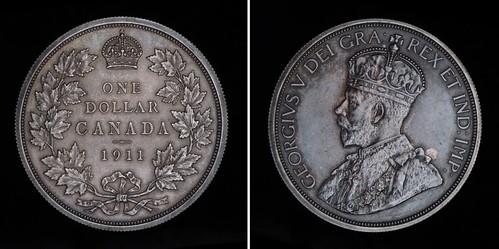
PREV ARTICLE
NEXT ARTICLE
FULL ISSUE
PREV FULL ISSUE
V25 2022 INDEX E-SYLUM ARCHIVE BANK OF CANADA MUSEUM ACQUIRES 1911 DOLLARThe Bank of Canada Museum has acquired a centerpiece: a 1911 silver dollar. -Editor
After being the apple of many a coin collector's eye, The 1911 silver dollar had been in private hands for more than 60 years, but was recently acquired by the museum from a Canadian collector and will now have a permanent home in the National Currency Collection at the Bank Street heritage centre. Unlike most coins that were mass produced, the 1911 silver dollar was never put into circulation, and only three trial strikes of the planned coin — or tests — were ever created: one in lead and two in silver. After being catalogued as pattern coins, which are not intended for circulation, the 1911 silver dollar strikes had quite the journey around the world, turning up in collections in the United States, Australia, the United Kingdom and, of course, Canada. The Emperor was purchased at a public coin auction in 2003 for $1.1 million by a George H. Cook, a collector from Calgary.
The Bank of Canada Museum recently posted an article detailing how the coin finally came to be in its possession this past year: The sale price for the coin when it was sold at a 2019 U.S. coin auction was $734,000 — considerably lower than anticipated. The three 1911 silver dollar specimens — nicknamed Emperor, King and Prince — are the three most coveted items among collectors of Canadian coins, and their uniting in the Bank of Canada Museum collection is the first time they have all been together since they were produced more than 110 years ago. It's a special moment for all Canadian coin and history lovers alike. Before becoming available to the public, the coin apparently belonged to the family of the Deputy Mint Master of the Royal Mint, William Frey Ellison-McCartney. When McCartney retired from the Royal Mint in 1912, he took it with him when he went on to become Governor of Tasmania. McCartney died in 1924 and the 1911 dollar was passed on to his three children. The coin was sold to a London dealer, Blair A. Seaby in 1960. From 1960 to 2021, the coin changed hands several times, landing in the collection of a couple of major Canadian collectors including John McKay-Clements, who was a businessman and former mayor of Haileybury, Ontario (he owned the coin from 1965 until his death in 1976), and George H. Cook of Calgary (2003-2018), an entrepreneur and last owner of the coin before he passed away in 2018. Between McKay-Clements and Cook, the coin changed hands on several occasions among Canadian and American coin dealers.
To read the complete article, see:
Wayne Homren, Editor The Numismatic Bibliomania Society is a non-profit organization promoting numismatic literature. See our web site at coinbooks.org. To submit items for publication in The E-Sylum, write to the Editor at this address: whomren@gmail.com To subscribe go to: https://my.binhost.com/lists/listinfo/esylum All Rights Reserved. NBS Home Page Contact the NBS webmaster 
|

